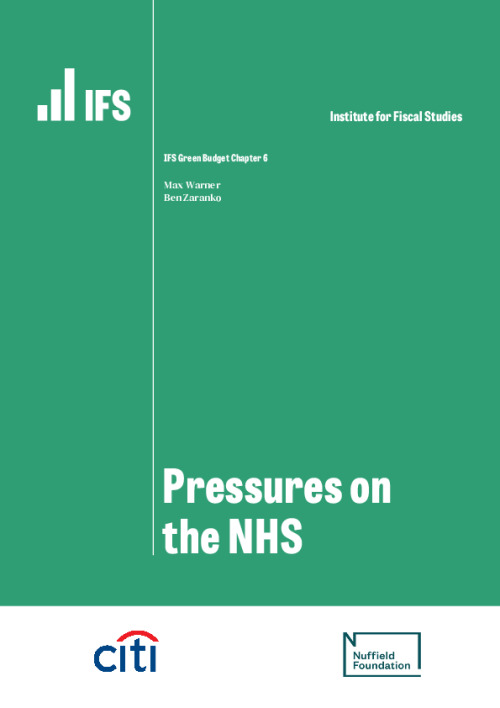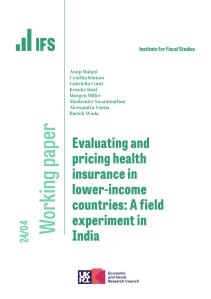The COVID-19 pandemic has had deep and far-reaching impacts on the National Health Service (NHS), putting incredible pressure on a health system that was already struggling to meet many of its constitutional targets even before the pandemic.
The success of the vaccination programme means that there is now less risk of COVID-19 patients overwhelming the system. But that does not mean the NHS is in the clear. In some senses, the challenge is only just beginning: the NHS will face ongoing costs and pressures from the pandemic for years to come. In the face of these pressures, and repeated requests for additional funding, the government has made a major announcement on health and social care funding. But will it be enough to meet the pressures facing the health service?
In this chapter, we assess the NHS’s starting point, in terms of its funding, resources and performance on the eve of the pandemic. We then turn to the pandemic-related pressures on the NHS over the next few years, and assess the adequacy of the government’s latest funding announcement by comparing it with our assessments of the scale of NHS funding pressures.
Figure 1. IFS central scenario for new NHS pressures

Note: Direct COVID costs are COVID-19 patients, PPE, infection control and vaccinations.
Source: Authors’ calculations using all sources in Section 6.4.
Key findings
- The NHS was showing clear signs of strain even before the pandemic began. The waiting list for elective treatment had grown by 50% since 2015; just 83% of A&E patients were seen within four hours in February 2020 (down from 92% in February 2015); and the estimated cost of eradicating the ‘high-risk’ maintenance backlog had quadrupled since 2010.
- Following a decade of big budget increases, between 2009−10 and 2019−20 UK government health spending grew at an average real-terms rate of 1.6% per year – lower than any previous decade in NHS history. The NHS entered the pandemic with 39,000 nursing vacancies in England, and fewer doctors, hospital beds and CT scanners per person than in many similar countries. Continued public sector pay restraint has meant real-terms pay cuts for many NHS staff: average pay for consultants in 2021 is 9% lower in real terms than it was in 2011. It is 4% lower for junior doctors and 5% lower for nurses.
- NHS funding plans have been blown out of the water by the pandemic. Theresa May’s 2018 settlement for the English NHS was to increase annual spending by an eventual £34 billion over five years. The Department of Health and Social Care spent £63 billion on COVID-19 support in 2020−21, and is planning to spend £34 billion in 2021−22. This includes an estimated £29 billion in additional NHS England funding (across both years), £28 billion for NHS Test and Trace and £15 billion on personal protective equipment (PPE).
- The NHS will continue to face direct and indirect pressures from COVID-19, and pre-pandemic funding plans would be insufficient to meet them. In our central scenario, we estimate that the English NHS will need £9 billion in 2022−23 (an increase of 6.4% relative to pre-pandemic plans), £6 billion in 2023−24 (4.1% on pre-existing plans) and £5 billion in 2024−25 to deal with pandemic-related pressures. These are substantial, but manageable, sums. These estimates are highly uncertain and sensitive to assumptions about the future course of the pandemic, but are broadly similar to those reached by other organisations.
- The new health and social care settlement, announced by the Prime Minister in September 2021, provides an additional £11.2 billion for the Department of Health and Social Care in 2022−23 and £9.0 billion in 2023−24. Of that, around £1.8 billion each year is earmarked for social care (assuming that the £5.4 billion over three years is spread evenly). That leaves around £9 billion of additional funding in 2022−23 and £7 billion in 2023−24, to deal with health-related COVID pressures. Based on our analysis, this could be enough to meet the pressures on the NHS over the next two years.
- But this new funding announcement is far less likely to be sufficient in the medium term. The extra funding provided for the NHS in the recent announcement will result in spending growing at 3.9% a year between 2018−19 and 2024−25, exactly the same rate of growth as was planned between 2018−19 and 2023−24. That suggests that these new plans allow for little or no long-term additional costs as a result of the pandemic, whereas we estimate that virus-related pressures could amount to £5 billion in 2024−25. Meeting those ongoing pressures would likely require additional funding, or less spending elsewhere in the NHS.
- Direct COVID pressures include the costs of treating patients with COVID-19 and ‘long COVID’, Test and Trace, vaccinations, PPE and other infection control measures. These pressures are substantial but are likely to fall rapidly from their current level. We estimate that the combined cost of meeting these direct pressures could be around £5.2 billion in 2022−23, falling to £2.0 billion in 2023−24 and £0.9 billion in 2024−25.
- The indirect costs and pressures associated with the pandemic could be greater and more persistent. Millions of people missed out on NHS care during the pandemic. Much of this care will need to be delivered eventually and waiting lists are likely to rise rapidly as these ‘missing’ patients come forward. We estimate that the NHS could need £2.5 billion per year between 2022−23 and 2024−25 if it is to catch up on missed activity. This could be sufficient to return waiting lists to their pre-pandemic levels within three years, if the NHS finds effective ways to boost capacity and unit costs do not increase substantially. Increased demand for mental health services could cost the NHS an additional £1 billion per year. An annual 3% pay rise for NHS staff, if continued over this period, would cost approximately £0.8 billion in 2022−23, £1.3 billion in 2023−24 and £1.8 billion in 2024−25 relative to the 2.1% annual increases assumed in the NHS’s long-term plan.
- The pandemic is also likely to save the NHS money in some areas. The move to remote outpatient appointments, combined with reduced demand as a result of COVID-19 deaths, could save the NHS at least £0.7 billion per year between 2022−23 and 2024−25. More broadly, the NHS has had to experiment hugely during the pandemic, and there are potential ‘upsides’ and gains from the resultant organisational learning.
This analysis was funded by the Nuffield Foundation as an early output of the 2021 IFS Green Budget.
The Nuffield Foundation is an independent charitable trust with a mission to advance educational opportunity and social well-being. It funds research that informs social policy, primarily in Education, Welfare and Justice. It also provides opportunities for young people to develop skills and confidence in science and research. The Foundation is the founder and co-funder of the Nuffield Council on Bioethics, the Nuffield Family Justice Observatory and the Ada Lovelace Institute. www.nuffieldfoundation.org | @NuffieldFound











